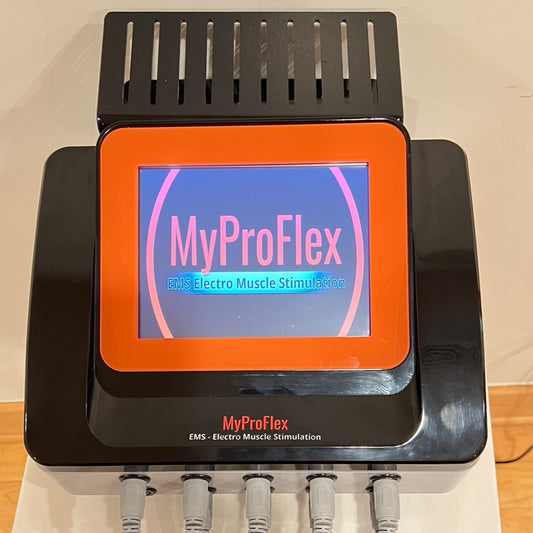
For Providers
MyProFlex EMS
EMS is a valuable tool for Coaches, Trainers, and Athletes seeking to optimize training outcomes, enhance performance, and support overall health and fitness goals. Its ability to improve muscle activation, strength, endurance, and recovery makes it a beneficial addition to any comprehensive training program.
Providers
- Fitness Trainers and Coaches: EMS is often used in fitness training to enhance muscle strength, endurance, and recovery. Fitness trainers and coaches can incorporate EMS into their programs to provide more effective workouts for their clients.
- Physical Therapists: EMS can aid in rehabilitation by stimulating muscles that may be weakened due to injury or surgery. Physical therapists use EMS to complement traditional therapy methods and expedite recovery.
- Athletic Trainers: Professionals working with athletes can use EMS for both injury prevention and rehabilitation. It helps in strengthening muscles, improving range of motion, and reducing recovery time after intense training or competition.
- Sports Teams and Clubs: EMS can be integrated into the training regimens of sports teams to improve overall athletic performance and reduce the risk of injuries.
- Dance, Yoga & Pilates Instructors: EMS can used muscle activation which aids in improved overall strength, Flexibility and Mobility.
- Medical Professionals: Some medical professionals use EMS for therapeutic purposes, such as pain management, muscle re-education, and improving circulation in patients with certain medical conditions.
- Beauty and Wellness Centers: EMS devices designed for aesthetic purposes can be used in beauty and wellness centers for muscle toning, body shaping, and cellulite reduction treatments.
- Personal Trainers: Individuals who provide one-on-one training sessions can incorporate EMS into their sessions to offer more personalized and effective fitness programs.
- Rehabilitation Centers: Facilities specializing in physical rehabilitation may use EMS as part of their treatment plans for patients recovering from injuries or surgeries.
- Home Users: There are also EMS devices available for personal use at home, allowing individuals to enhance their fitness routines or manage certain medical conditions under guidance.
- Research Institutions: Researchers studying muscle physiology, sports science, or rehabilitation techniques may use EMS in their studies to understand its effects on muscle performance and recovery.
Benefits For Professionals & Providers
- Muscle Building Support: Accelerate muscle building with targeted muscle stimulation, helping athletes achieve peak performance and maximize training efficiency.
- Enhanced Muscle Recruitment: EMS activates a higher percentage of muscle fibers compared to voluntary contractions alone. This allows trainers and coaches to optimize muscle activation during workouts, leading to improved strength gains and muscle development.
- Efficient Workouts: EMS can be used concurrently with traditional exercises or during rest periods, maximizing training efficiency. This is particularly advantageous for athletes and clients with limited time for training sessions.
- Strength and Power Development: By targeting deeper muscle fibers, EMS enhances muscular strength and power, which are crucial for athletes looking to improve performance in sports requiring explosive movements (e.g., sprinting, jumping).
- Improved Muscle Endurance: EMS helps to increase muscle endurance by improving the oxidative capacity of muscle fibers. This is beneficial for athletes participating in endurance sports (e.g., distance running, cycling) and activities requiring sustained muscle effort.
- Injury Prevention and Rehabilitation: EMS can aid in injury prevention by strengthening muscles and supporting joint stability. It is also used in rehabilitation settings to maintain muscle mass and function during periods of reduced physical activity or recovery from injuries.
- Targeted Muscle Conditioning: EMS allows trainers and coaches to target specific muscle groups effectively. This is particularly useful for addressing muscle imbalances and enhancing overall muscle symmetry and coordination.
- Recovery Enhancement: EMS promotes faster recovery by increasing blood flow to targeted muscles, reducing post-exercise soreness, and accelerating the removal of metabolic waste products. This helps athletes recover more quickly between training sessions and competitions, allowing athletes to train harder and more frequently
- Versatility in Training: EMS can be integrated into various training protocols, including strength training, endurance training, plyometrics, and flexibility exercises. This versatility allows trainers to tailor workouts to meet the specific needs and goals of their clients and athletes.
- Progress Tracking and Monitoring: Many EMS devices offer features for monitoring and adjusting training intensity and duration, allowing trainers to track progress over time and make informed adjustments to training programs.
- Competitive Edge: For athletes, EMS can provide a competitive edge by complementing traditional training methods and helping to achieve peak performance levels more efficiently.
Benefits for Physical Therapists, Chiropractors & Patients:
EMS technology offers a non-invasive and effective approach to pain management, rehabilitation, and wellness enhancement for patients under the care of physical therapists and chiropractors. Its versatility and therapeutic benefits make it a valuable tool in restoring and maintaining optimal musculoskeletal health.
- Pain Management: EMS helps alleviate acute and chronic pain by stimulating sensory nerves and blocking pain signals. This can provide relief for patients suffering from conditions such as arthritis, back pain, and muscle strains.
- Muscle Rehabilitation: EMS aids in muscle rehabilitation by promoting muscle re-education and preventing muscle atrophy. This is particularly useful for patients recovering from injuries, surgeries, or prolonged periods of immobilization.
- Enhanced Blood Circulation: EMS improves blood flow to targeted muscles, which accelerates the delivery of nutrients and oxygen while removing metabolic waste products. This promotes tissue healing and reduces inflammation.
- Reduced Muscle Spasms: By inducing muscle contractions, EMS helps to reduce muscle spasms and tightness, providing immediate relief and enhancing muscle flexibility and range of motion.
- Functional Restoration: EMS assists in restoring normal muscle function and coordination, which is essential for patients recovering from neurological conditions, stroke, or orthopedic injuries.
- Customized Treatment Plans: EMS devices offer adjustable intensity levels and program settings, allowing physical therapists and chiropractors to customize treatment plans based on the specific needs and progress of each patient.
- Complementary Therapy: EMS can be used alongside traditional physical therapy techniques to enhance treatment outcomes. It serves as a supplementary tool to strengthen muscles, improve joint stability, and optimize overall rehabilitation progress.
- Patient Engagement: Many patients find EMS therapy engaging and motivating, as it provides tangible feedback through muscle contractions and improvements in pain relief and mobility.
- Postural Correction: EMS can help correct muscular imbalances and improve posture, which is beneficial for patients experiencing chronic pain due to poor posture or repetitive strain injuries.
- Long-term Benefits: Regular use of EMS can lead to long-term benefits such as improved muscle tone, increased joint stability, and enhanced overall functional independence, promoting a higher quality of life for patients.
Key Features:
- Advanced EMS Technology: MyProFlex delivers precise electrical impulses to mimic natural muscle contractions, optimizing strength, endurance, and recovery.
- Versatile Applications: Ideal for strength training, endurance enhancement, rehabilitation, pain management, and recovery in diverse clinical and fitness settings.
- Intuitive Operation: User-friendly interface and programmable settings make MyProFlex accessible for both professionals and users.
- Durable Design: Built to withstand frequent use in fitness centers, clinics, and rehabilitation facilities, ensuring longevity and reliability. Machine Lightweight and portable, with a customized suitcase that can be carried to location and also on a plane as carry on luggage.
Financial benefits
The financial benefits of using EMS (Electrical Muscle Stimulation) for providers can vary depending on the specific context and application. Here are some potential financial advantages:
- Increased Revenue Streams: Integrating EMS into a practice can create new revenue streams through additional services offered to patients or clients. This might include EMS sessions as part of rehabilitation programs, fitness training packages, or aesthetic treatments.
- Competitive Edge: Offering EMS can differentiate a practice from competitors by providing innovative and effective treatments that attract new patients or clients seeking advanced therapeutic options.
- Enhanced Patient Outcomes: Improved patient outcomes can lead to higher patient satisfaction and retention rates, which in turn can contribute to the financial health of a practice through positive word-of-mouth referrals and repeat business.
- Efficiency and Time Savings: EMS can potentially optimize treatment times and improve patient throughput, allowing providers to see more patients or clients without sacrificing quality of care.
- Cost Savings in Rehabilitation: For rehabilitation centers, EMS can aid in faster recovery times and potentially reduce overall treatment costs associated with longer rehabilitation periods or complications.
- Diversification of Services: By offering EMS alongside existing services, providers can diversify their service offerings and cater to a broader range of patient needs, potentially attracting new demographics.
- Utilization of Existing Space and Equipment: EMS devices often require minimal additional space and can be integrated into existing treatment rooms or gym areas, maximizing the use of facilities and equipment.
- Insurance Reimbursement: In some cases, EMS may be reimbursable by insurance companies for specific medical indications, providing a source of revenue through insurance claims.
- Long-term Benefits: Over time, the investment in EMS technology can pay off in terms of patient outcomes and business growth, contributing to a sustainable financial model for the practice.
- Marketing Opportunities: Highlighting EMS as a feature of the practice in marketing efforts can attract new patients or clients who are specifically seeking out EMS services for fitness, rehabilitation, or aesthetic purposes.
The potential financial benefits can make EMS a worthwhile addition to a Provider’s offerings, enhancing both patient care and business viability.
MyProFlex EMS
Electro Muscle Stimulation
-
MyProFlex EMS Mini
Normaler Preis $500.00 USDNormaler PreisGrundpreis / pro -
MyProFlex EMS
Normaler Preis $6,500.00 USDNormaler PreisGrundpreis / pro

